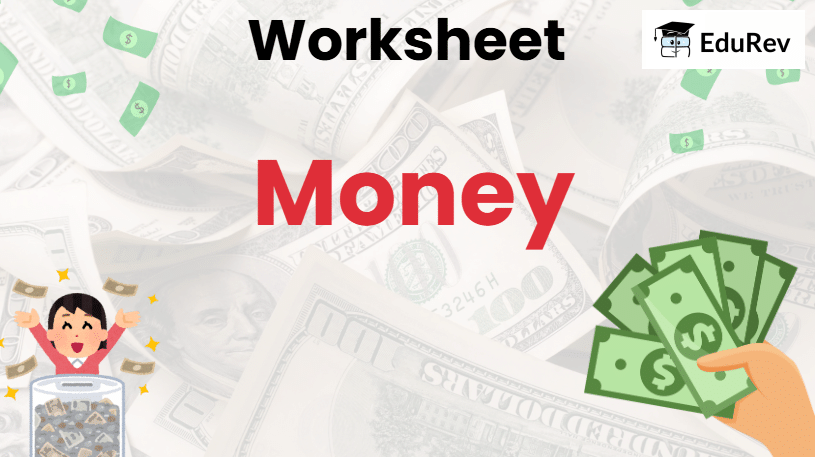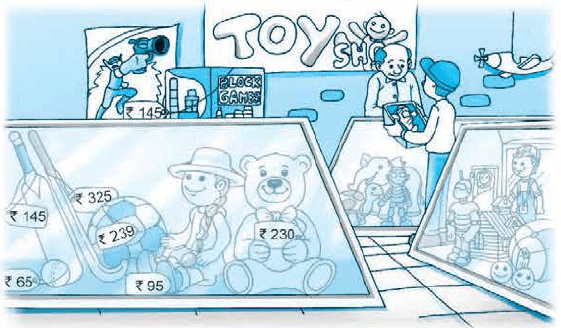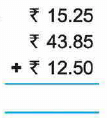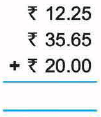Class 3 Maths - Money - CBSE Worksheets

Q1: Express the following in short form:
a) 40 rupees 40 paise = ₹ ______
b) 25 rupees 10 paise = ₹ ______
c) 7 rupees 60 paise = ₹ ______
Q2: Write in words:
a) ₹ 35.25 ______
b) ₹ 0.75 ______
c) ₹ 2.12 ______
Q3: Check the prices of various things at shop and find the cost of the following:
a) A hockey stick and a cricket bat
= ______ + ______ = ______
b) A teddy bear and a doll
= ______ + ______ = ______
c) A cricket bat and a ball
= ______ + ______ = ______
Q4: Convert the following rupees into paise:
a) ₹ 88.88
b) ₹ 32.45
c) ₹ 4.06
Q5: Convert the following into paise:
a) ₹ 7 and 35 paise
b) ₹ 8 and 42 paise
c) ₹ 4 and 95 paise
d) ₹ 87
e) ₹ 6 and 75 paise
Q6: Convert the following into rupees:
a) 2100 p
b) 700 p
c) 1400 p
d) 75 p
e) 6500 p
Q7: Fill in the blanks:
a) 1045 paise = ₹ ______
b) 8 rupees and 15 paise = ______ paise
c) 2960 paise = ₹ ______
Q8: Convert the following into paise:
a) ₹ 57.75
b) ₹ 19.50
c) ₹ 12.96
d) ₹ 80.80
e) ₹ 97.65
Q9: Solve:
a) Mona bought a pencil for ₹ 15, a pen for ₹ 25.50 and a notebook for ₹ 45. 75. Find the total money spent by her.
b) Roger went for shopping and bought a toy for ₹ 25.75 and a bat for ₹ 40.20 . How much money did he spend in all?
c) Radha gave ₹ 56.90 to her daughter and ₹ 35.50 to her son . Find the total money given by Radha to her children.
d) Sushma bought potatoes for ₹ 12.50, tomatoes for ₹ 16.25 and onions for ₹ 20.00. How much did she spend in all?
Q10: Add the following by converting into paise:
a) ₹ 33.50 + ₹ 29.68
b) ₹ 69.70 + ₹ 25.25
c) ₹ 45.50 + ₹ 25.50
d) ₹ 58.75 + ₹ 29.50
Q11: Add each of the following:
Q12: Solve the following:
a) A woman had ₹ 180 with her. She bought vegetables for ₹ 65.50. How much money was left with her?
b) The cost of a book is ₹ 75.50. Shikha has only ₹ 69.25. How much more money does she need to buy the book?
c) Rishabh wants to buy a hat that costs ₹ 96.50. He has ₹ 57. How much more money does Rishabh need to buy the hat?
Q13: Subtract the following by converting them into paise:
a) ₹ 65.75 - ₹ 28.36
b) ₹ 20.50 - ₹ 14.30
c) ₹ 95.50 - ₹ 53.30
d) ₹ 52.40 - ₹ 16.10
Q14: Subtract the following:
Q15: Which is lesser: ₹ 100.05 or ₹ 100.50? ______
Q16: How much is ₹ 25.50 less than ₹ 50? ______
Q17: ₹ 36.40 = ______ paise.
Q18: Find the total money in each bill. Also, in each case, find the amount received as change.
Q19: In short, 200 rupees 5 paise can be written as ______.
Q20: In short, 40 paise can be written as ______.
You can access the solutions to this worksheet here.
|
20 videos|163 docs|25 tests
|
FAQs on Class 3 Maths - Money - CBSE Worksheets
| 1. What are the different types of money? |  |
| 2. How is money created? |  |
| 3. What is the role of money in an economy? |  |
| 4. How does inflation affect the value of money? |  |
| 5. What are the advantages of using digital money? |  |





















